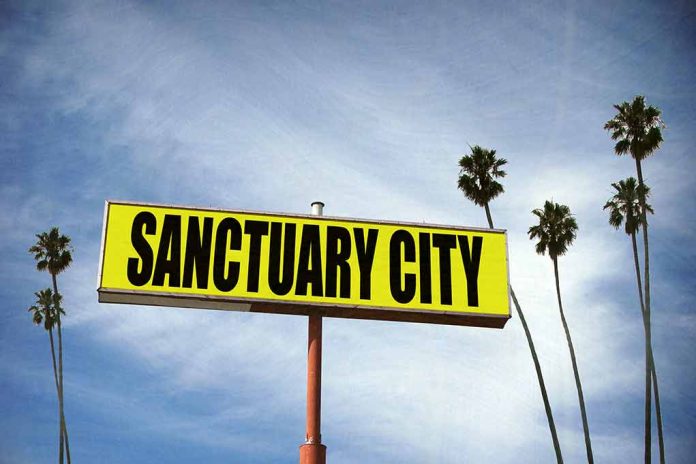
ICE Chief Tom Homan declared “We’re gonna triple the workforce in sanctuary cities” as a direct challenge to local politicians who have hindered federal immigration enforcement while Venezuelan gangs terrorize American communities.
Key Takeaways
- The Trump administration has launched aggressive deportation operations focusing on sanctuary cities, with ICE arresting 956 people in a single day.
- Border Czar Tom Homan is intensifying efforts in defiant sanctuary jurisdictions where local policies protect criminals, particularly in cities like New York where Venezuelan gang violence has surged.
- The administration has already deported 7,300 illegal immigrants in the first week of Trump’s second term, with operations continuing in major cities across the country.
- Local resistance remains significant, with the New York City Council filing a lawsuit against Mayor Eric Adams’ executive order allowing ICE to operate at Rikers Island.
- Federal officials warn that impeding immigration enforcement is a crime, suggesting potential legal consequences for uncooperative jurisdictions.
ICE Launches Nationwide Enforcement Campaign
Under President Trump’s administration, U.S. Immigration and Customs Enforcement has dramatically expanded deportation operations across major American cities, with a strategic focus on sanctuary jurisdictions that have historically obstructed federal immigration enforcement. Led by former ICE Director Tom Homan, these operations have already yielded significant results, with federal agents arresting 956 people in a single day – the largest round of arrests in the administration’s current term. The enforcement campaign is coordinated with multiple federal agencies including the U.S. Marshals Service, ATF, DEA, and FBI, demonstrating the whole-of-government approach to addressing the illegal immigration crisis.
“Sanctuary cities are difficult to operate in. We’d much rather arrest — one agent can arrest one bad guy in jail in 10 minutes. But when they release them back into the community, we’ve got to send a whole team to find him, and some of them don’t want to be found,” said Tom Homan.
The operations have stretched across the country, with raids conducted in New York City, Chicago, Los Angeles, Philadelphia, Phoenix, San Diego, Denver, Miami, Atlanta, various cities in Texas, Seattle, and San Juan, Puerto Rico. Secretary of Homeland Security Kristi Noem personally joined enforcement operations in New York that began Tuesday, signaling the administration’s commitment to direct involvement in these critical public safety missions. The strategic approach includes targeting three major U.S. cities per week, systematically addressing areas where illegal criminal activity has flourished under protective sanctuary policies.
Venezuelan Gang Violence Prompts Escalated Response
The administration’s intensified focus on sanctuary cities comes in direct response to escalating gang violence, particularly involving the Venezuelan Tren de Aragua gang, whose members have committed high-profile crimes in multiple U.S. cities. In Denver, law enforcement arrested 50 members of this notorious organization, while the gang’s leader was apprehended in New York. The situation became particularly inflammatory after teenaged illegal immigrants affiliated with this gang attacked NYPD officers in Times Square, an incident that highlighted the direct consequences of sanctuary policies that prevent local law enforcement from cooperating with federal immigration authorities.
“We’re gonna flood the zone with officers,” said Tom Homan.
Homan highlighted a successful RICO investigation that led to the indictment of 27 gang members, showcasing the potential effectiveness of federal and local law enforcement collaboration when properly executed. This strategic use of racketeering charges has proven effective against organized criminal networks operating within immigrant communities. The administration has identified over 660,000 criminal foreign nationals for deportation, many of whom currently live freely in American communities due to sanctuary policies that shield them from federal authorities.
Confronting Sanctuary City Resistance
The administration’s enforcement efforts face significant challenges from entrenched sanctuary policies in many major cities. In New York City, a contentious battle has erupted between Mayor Eric Adams, who issued Executive Order 50 inviting ICE to operate an office in Rikers Island jail, and the City Council, which filed a lawsuit to block this cooperation. Meanwhile, NYPD Commissioner Jessica Tisch has taken a defiant stance against federal immigration enforcement, declaring that “The NYPD does not engage in civil immigration issues—period,” despite the clear public safety implications of this non-cooperation policy.
“The mayor in New York says he wants to help, but the city council is stopping him. The commissioner of the NYPD is saying they’re not going to help,” explained Tom Homan.
Federal officials have emphasized that sanctuary jurisdictions are not above the law. “Impeding a federal law enforcement officer is a crime,” said Homan, suggesting potential legal consequences for jurisdictions that actively obstruct immigration enforcement. The administration is reportedly considering penalties including withholding federal funds from uncooperative law enforcement agencies and local governments. Despite resistance, early results show the policy’s effectiveness – the Trump administration deported 7,300 illegal immigrants in just the first week of his second term, with numbers expected to rise as operations continue.
A Focus on Public Safety
Administration officials emphasize that their enforcement priorities focus on removing dangerous criminals rather than indiscriminate deportations. The current strategy targets national security threats and violent criminals first, addressing the most immediate public safety concerns in affected communities. This approach seeks to build bipartisan support by focusing on common-sense public safety outcomes that benefit all Americans, regardless of political affiliation. The administration has also reported encouraging early results at the southern border, with a decrease in illegal crossings attributed to the renewed interior enforcement.
“What mayor or governor doesn’t want public safety threats out of their communities? That’s their number one responsibility is to protect their communities. That’s exactly what we are going to do,” said Tom Homan.
Despite attempts to frame the operations as controversial, ICE officials emphasize the targeted nature of their work. “We focus on the worst of the worst and all the political rhetoric is not helping,” explained Todd Lyons, a senior ICE official. The administration’s message to sanctuary cities is clear and uncompromising. As Homan bluntly summarized their approach to criminal aliens protected by sanctuary policies: “We’re comin’ for ’em.” With operations continuing to expand and resources being redirected to problematic jurisdictions, the confrontation between federal enforcement and sanctuary policies appears set to intensify in the coming months.









